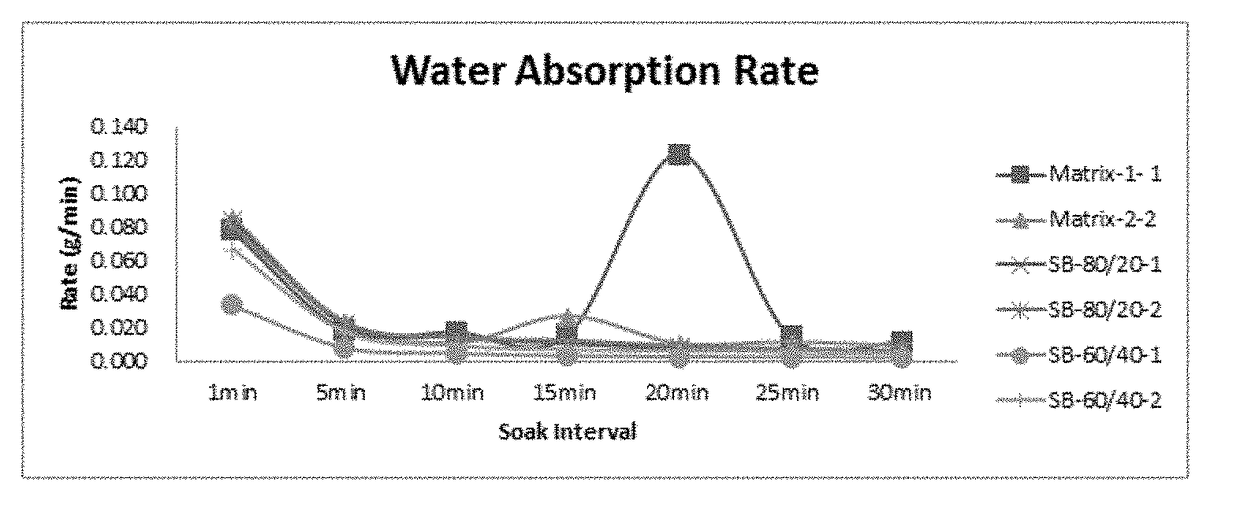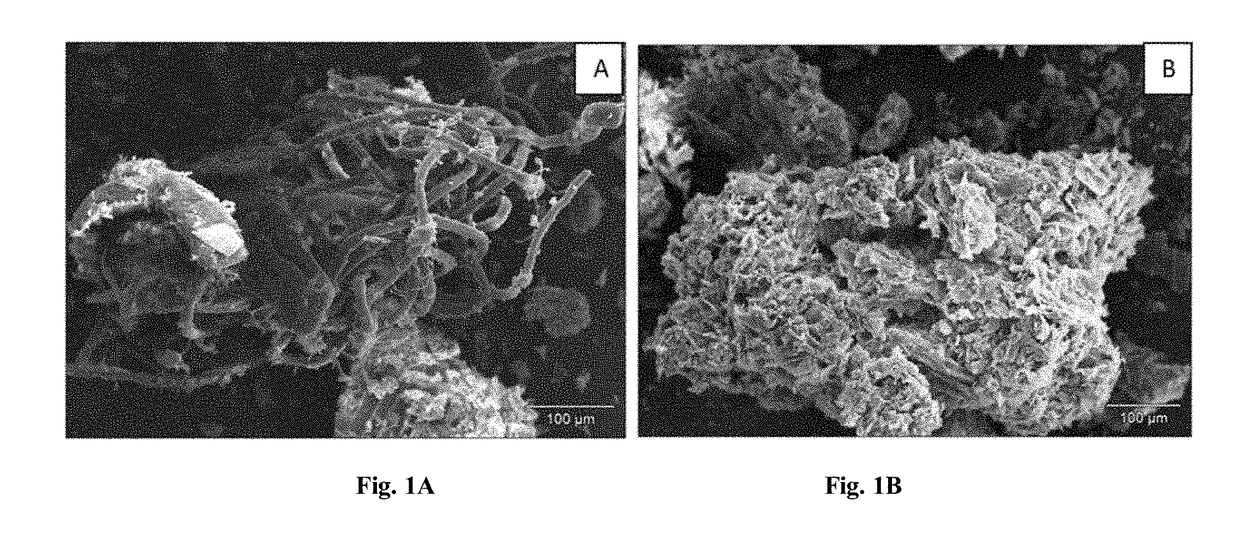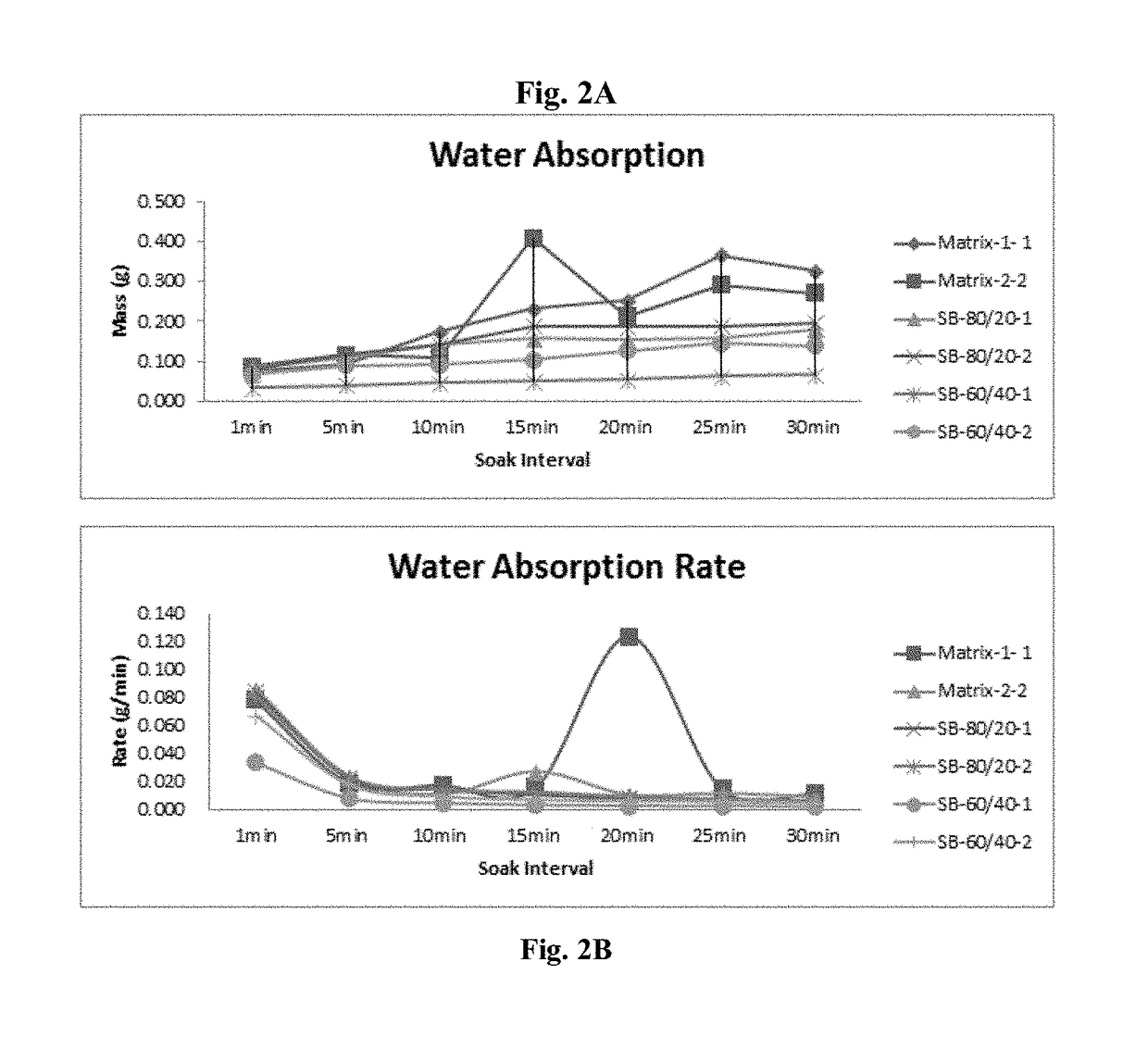Starch Foams Using Specialized Lignin
a technology of starch foam and lignin, which is applied in the direction of lignin derivatives, organic chemistry, chemistry apparatus and processes, etc., can solve the problems of poor fire retardant performance, poor uv resistance, and poor performance of products,
- Summary
- Abstract
- Description
- Claims
- Application Information
AI Technical Summary
Benefits of technology
Problems solved by technology
Method used
Image
Examples
examples
[0182]The following examples serve to illustrate certain embodiments and aspects and are not to be construed as limiting the scope thereof.
[0183]Materials
[0184]Making the starch-based foam blend with fiber involves the selection of starch, fiber, foam agent, and plasticizer. The lignin material (clean lignin) used in this study was produced by Sweetwater Energy (Rochester, N.Y., USA). It is a lignin-enriched nonsulfonated fractionated residue extracted following yeast fermentation. The fraction is comprised of 34.1% lignin, 22.3% cellulose, and 0.1% hemicellulose. Remaining contents include protein, ash, and lignin-carbon compounds.
[0185]The corn starch (MP Biomedicals) was comprised of 75% amylopectin and 25% amylose, with a pH level of 4.9, and approximately 11-15% moisture content. Tap water was used as a swelling agent. Citric acid and sodium bicarbonate, as blowing agents, were added into the starch mix to improve the cell growth and expansion characteristics. The critic acid m...
example 2
Particle Size Following Pretreatment with a Twin Screw Extruder
[0210]The experiment was conducted to evaluate the particle size reduction that takes place during biomass pretreatment in a modified twin screw extruder. Cherry sawdust, with an average particle size of about 3 mm×3 mm×1 mm and an average moisture content of 31% was used as the raw biomass feedstock. The cherry biomass was fed into a ZSK-30 twin screw extruder, manufactured by Coperion, essentially as described in Example 1. The processing parameters used for the experiment are presented in Table 4.
TABLE 4Particle Size Distribution Experimental ParametersMassAcidWaterResidenceThroughputPressureTemp.AdditionAdditionTimeFeedstockDry g / minpsig° C.g / ming / minsecondsCherry398.44002317.6113410Sawdust
[0211]The cherry sawdust was processed on a continuous basis. The final moisture content of the processed cherry sawdust was about 76.8%. Once steady state was achieved a sample of the pretreated material was collected for particle...
example 3
Bulk Density of Hydrolysate-Derived Lignin
[0212]Two 250-mL samples of lignin were prepared and shipped for testing to determine bulk density as well as other powder flow characteristics. The majority of one sample had a mean particle size of 10-μm. The second sample was placed through a 1-mm sieve where all particles 1-mm and smaller were allowed to pass through. The 1-mm sieve was selected based on the maximum particle size allowable for the powder flow measurement technology. The lignin was derived from barkless mixed hardwood.
[0213]The hardwood was pretreated using the above-described pretreatment technology for conversion of available C5 sugars. The material was subsequently subjected to enzymatic hydrolysis and separation for the removal of available C6 sugars. The remaining lignin in suspension was then processed for solids removal. The material was initially separated to 50% total solids removing the majority of the dissolved solids in solution. Remaining sugars were measured...
PUM
| Property | Measurement | Unit |
|---|---|---|
| compressive strength | aaaaa | aaaaa |
| compressive strength | aaaaa | aaaaa |
| density | aaaaa | aaaaa |
Abstract
Description
Claims
Application Information
 Login to View More
Login to View More - R&D
- Intellectual Property
- Life Sciences
- Materials
- Tech Scout
- Unparalleled Data Quality
- Higher Quality Content
- 60% Fewer Hallucinations
Browse by: Latest US Patents, China's latest patents, Technical Efficacy Thesaurus, Application Domain, Technology Topic, Popular Technical Reports.
© 2025 PatSnap. All rights reserved.Legal|Privacy policy|Modern Slavery Act Transparency Statement|Sitemap|About US| Contact US: help@patsnap.com



